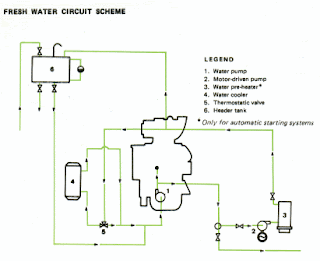Uniflo and loop scavenging

2 stroke engines with an exhaust valve mounted in the cylinder head are known as uniflow scavenged engines. This is because the flow of scavenging air is in one (uni) direction. MAN B&W MC series uniflow scavenged engine Some 2 stroke engines do not have exhaust valves; As well as scavenge ports in the cylinder liner, they are fitted with exhaust ports located just above the scavenge ports. As the piston uncovers the exhaust ports on the power stroke, the exhaust gas starts to leave the cylinder. When the scavenge ports are uncovered, scavenge air loops around the cylinder and pushes the remaining exhaust gas out of the cylinder. This type of engine is known as a loop scavenged engine. Note that the piston skirt is much longer than that for a uniflow scavenged engine. This is because the skirt has to seal the scavenge and exhaust ports when the piston is at TDC. Although simpler in constru...







